Creamy Kimchi Udon: Your Go-To 20-Minute Spicy Noodle Recipe
Prepare for a flavor explosion with this incredibly easy and unbelievably delicious Creamy Kimchi Udon recipe! In just 20 minutes, you can transform simple ingredients into a show-stopping weeknight meal that’s packed with tangy kimchi, savory bacon, and irresistibly chewy udon noodles. It’s the perfect blend of spicy, creamy, and satisfying – guaranteed to become a new favorite in your culinary rotation.
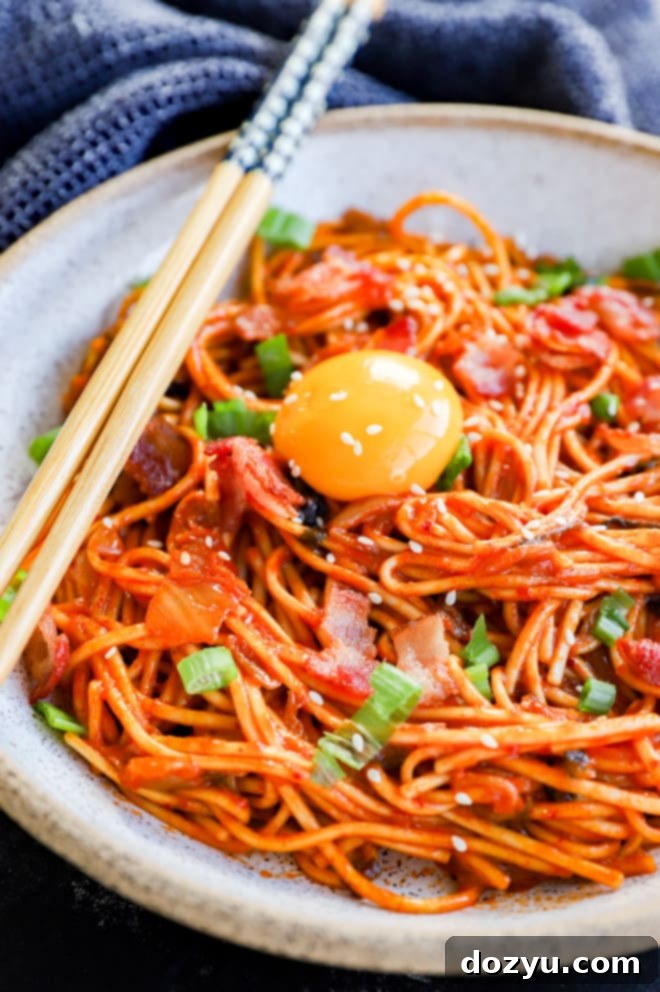
Table of Contents
Toggle
About This Creamy Kimchi Udon Recipe
There’s something incredibly satisfying about a noodle dish that delivers immense flavor without demanding hours in the kitchen. This creamy kimchi udon recipe is precisely that – a culinary delight born from the vibrant flavors of Korean cuisine, yet designed for maximum ease. It’s a testament to how simple ingredients, combined thoughtfully, can create a truly exceptional meal in under half an hour.
My love for kimchi runs deep. This fermented cabbage isn’t just a condiment; it’s a foundation for countless incredible dishes, offering a unique blend of spice, tang, and umami. It transforms ordinary meals into extraordinary experiences, and in this udon dish, it truly shines. Paired with the rich, thick texture of udon noodles and a savory, spicy, and creamy sauce, kimchi elevates this recipe to new heights.
If your busy weeknights often leave you craving something quick, delicious, and a little bit adventurous, then this kimchi udon is your answer. It’s engineered for speed and convenience, coming together in a single skillet in just 20 minutes. The magic happens as the tangy kimchi caramelizes with savory gochujang, creating a deep, complex base that perfectly complements the chewy udon noodles.
What makes this dish truly special is its adaptability. While delicious on its own, it also provides a fantastic canvas for customization. Feel free to incorporate your favorite proteins like succulent chicken, tender steak, flavorful pork, or even quick-seared shrimp. You can also boost its nutritional value and texture by adding a medley of fresh vegetables, turning it into a hearty kimchi udon stir-fry.
This recipe promises a “wow” factor with minimal effort, making it ideal for busy individuals, families, or anyone looking to enjoy restaurant-quality flavors at home. So, get ready to experience a taste sensation that will tantalize your taste buds and leave you feeling completely satisfied.
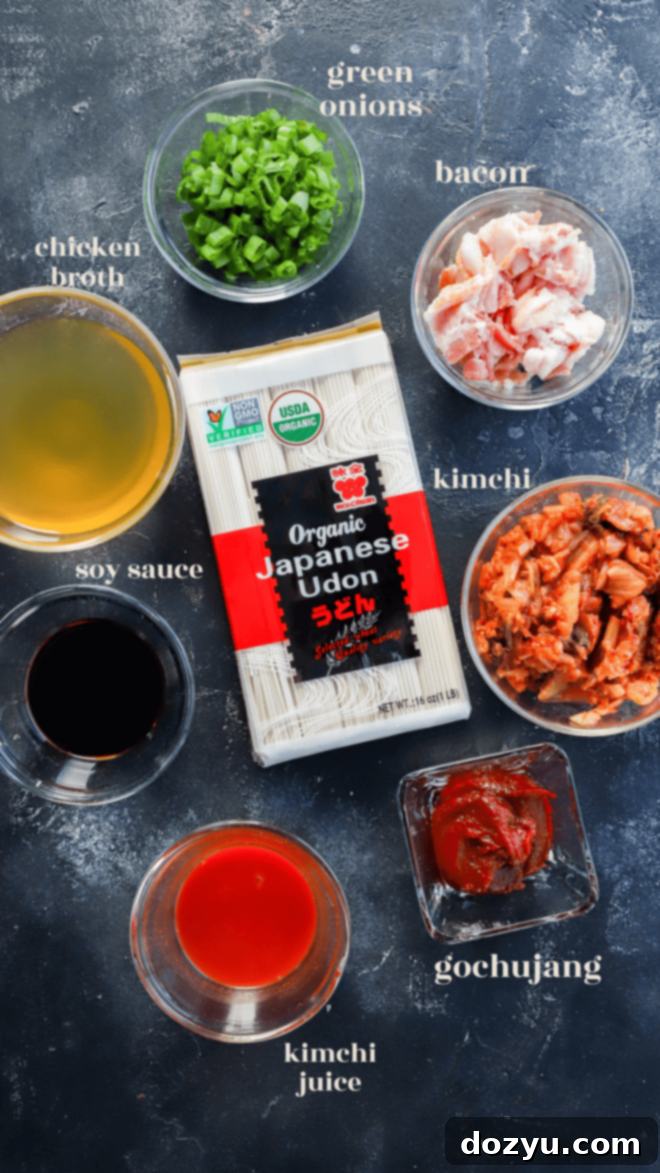
Ingredients for Kimchi Udon
Crafting this flavorful Kimchi Udon requires a handful of key ingredients, each playing a crucial role in building its distinctive taste and creamy texture. Here’s a closer look at what you’ll need and why each component is important:
- Bacon: While any bacon works, I highly recommend using thick-cut bacon for this recipe. Its robust flavor and satisfying crispiness add a fantastic textural contrast and savory depth to the dish. The rendered bacon fat also provides a rich base for cooking the kimchi.
- Udon Noodles: The star of the dish! Udon noodles are known for their wonderfully thick, chewy texture. You can use fresh, frozen, or dried udon noodles, depending on what’s available to you. Frozen udon often offers the best chewy consistency, closely mimicking fresh noodles. Be sure to follow package instructions for cooking these before adding them to the sauce.
- Kimchi: The heart and soul of this recipe. Kimchi, a traditional Korean fermented cabbage, brings a complex profile of spicy, sour, and umami flavors. Its fermentation adds a wonderful depth that cannot be replicated. Choose your favorite brand; you can often find good quality kimchi at your local grocery store or any Asian market. The older (more fermented) the kimchi, the more tangy and flavorful it will be.
- Kimchi Juice: Don’t discard the liquid from your kimchi jar! This juice is liquid gold, intensely flavorful and crucial for deepening the kimchi essence in our sauce. It’s packed with fermented goodness that boosts the overall tang and spice.
- Gochujang: This is a cornerstone of Korean cooking. Gochujang is a savory, sweet, and spicy fermented red chili paste. It provides not just heat but also a unique sweetness and depth that helps caramelize the kimchi beautifully, adding layers of flavor to the sauce. Adjust the amount to your preferred spice level.
- Broth: You can opt for either chicken broth or vegetable broth. Both provide a savory liquid base that helps create the creamy sauce and mellows the intensity of the kimchi and gochujang. Choose low-sodium options if you’re mindful of salt intake, as soy sauce also contributes sodium.
- Soy Sauce: A staple for adding umami and saltiness. I prefer using low-sodium soy sauce to control the overall saltiness of the dish, allowing you to season to taste at the end.
- Unsalted Butter: Butter is added at the end to create a luxurious, creamy texture, enriching the sauce and coating the noodles beautifully. Using unsalted butter gives you full control over the final seasoning. If you only have salted butter, simply taste before adding any extra salt.
- Scallions (Green Onions): Freshly chopped scallions are essential for garnish. They add a bright, fresh, and slightly pungent “zing” that cuts through the richness of the dish, providing a lovely textural and flavor contrast.
- Egg Yolks: (Optional, but highly recommended!) Raw egg yolks, added just before serving, are the secret to achieving an extra level of incredible creaminess. As you mix them into the hot noodles, they gently cook, creating a silky, rich sauce that clings to every strand.
Essential Kitchen Tools
One of the beauties of this Kimchi Udon recipe is its simplicity in terms of equipment. You won’t need an arsenal of kitchen gadgets, just a few basics to get the job done efficiently and deliciously.
For ingredient preparation, a good quality chef’s knife and a sturdy cutting board are all you need to chop your bacon, kimchi, and scallions. Investing in a sharp knife makes the prep process much quicker and safer.
The star of the cooking process is undoubtedly your skillet. This is truly a one-pan meal! I personally love using a well-seasoned cast iron skillet, like this budget-friendly Lodge cast iron skillet, because it provides excellent heat retention and even cooking, contributing to that perfectly caramelized kimchi. However, any large skillet with high sides will work beautifully. The high sides are important to contain all the noodles and sauce, allowing for easy tossing and mixing without spills. A non-stick skillet can also be a good option for easier cleanup.
Beyond that, a pair of kitchen tongs can be helpful for tossing the noodles and sauce, ensuring everything is thoroughly coated. That’s it! Minimal tools mean minimal cleanup, which is always a win on a busy weeknight.

How to Make Creamy Kimchi Udon
This recipe is designed for maximum flavor with minimal fuss, coming together in just a few simple steps. Follow these instructions to create your perfect bowl of creamy, spicy kimchi udon:
Crisp the Bacon
Start by placing your chopped bacon in a large skillet over medium-high heat. Cook the bacon, stirring occasionally, until it’s beautifully crispy and golden brown. This usually takes about 3 to 4 minutes. Once cooked, use a slotted spoon to transfer the crispy bacon pieces to a plate lined with paper towels to drain excess fat. Leave approximately 1 tablespoon of rendered bacon fat in the skillet – this flavorful fat will be the base for our incredible sauce. Discard any remaining bacon fat.
Prepare the Creamy Kimchi Sauce
Return the skillet, with the reserved bacon fat, to medium-high heat. Add the chopped kimchi and gochujang paste to the pan. Cook this mixture, stirring frequently, until the kimchi begins to soften and caramelize around the edges, typically taking about 4 minutes. This step is crucial as it deepens the flavors of the kimchi and gochujang, creating a rich, savory, and slightly sweet base.
Next, pour in the chicken or vegetable broth, soy sauce, and the precious kimchi juice. Bring this mixture to a gentle simmer. Continue to cook, stirring occasionally, for about 4 to 5 minutes, or until the liquid has slightly reduced and the sauce has thickened to a luscious consistency. This simmering allows all the flavors to meld beautifully.
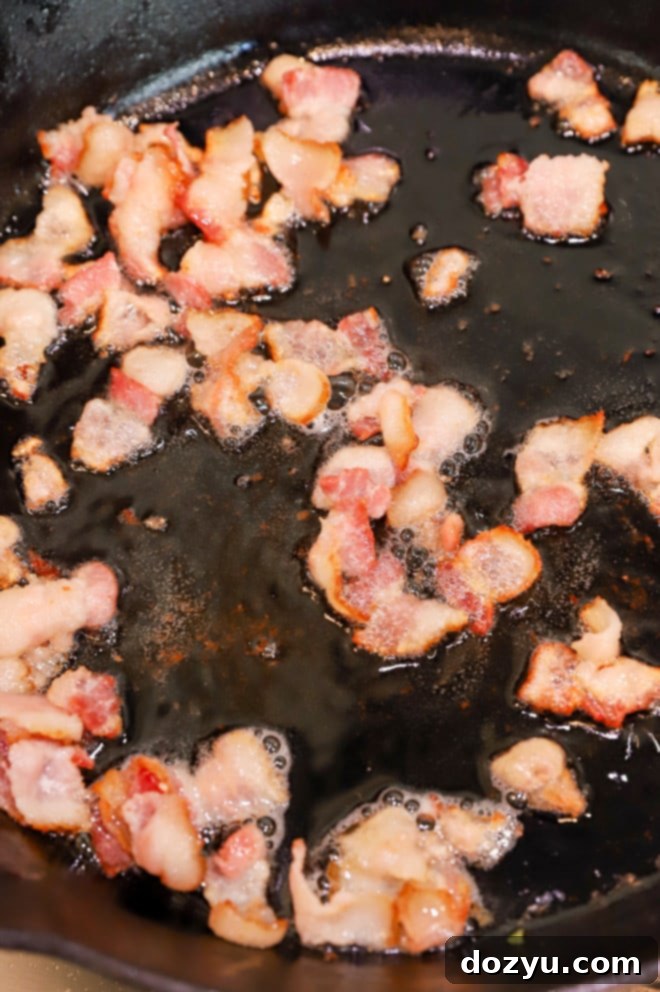
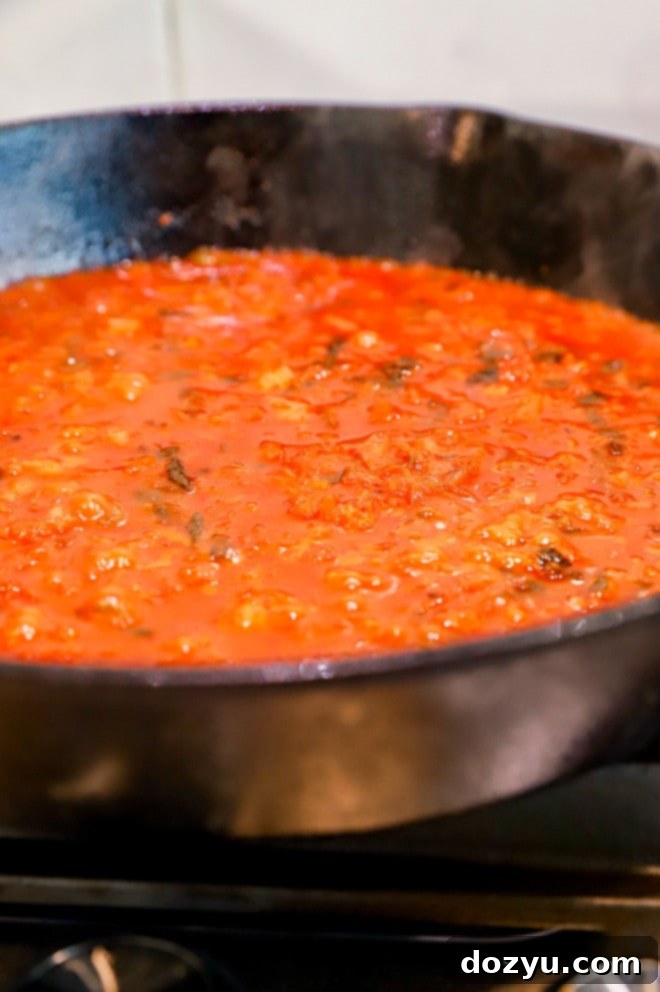
Cook the Udon Noodles
While your sauce is simmering and reducing, prepare the udon noodles according to the package directions. Cooking times can vary significantly depending on whether you’re using fresh, frozen, or dried noodles. Ensure they are cooked al dente, meaning they are tender but still have a pleasant chewiness. Overcooked udon can become mushy, so keep an eye on them!
Combine and Serve
Once the udon noodles are cooked, drain them thoroughly. Add the drained noodles directly to the skillet with the simmering kimchi sauce, along with the unsalted butter. Toss everything together vigorously, ensuring every thick strand of udon is thoroughly coated in the rich, creamy sauce. Continue to cook for about 2 minutes, allowing the noodles to absorb the flavors and the butter to fully melt and integrate.
Stir in most of the crispy bacon, reserving a small handful for garnish. Taste the noodles and season with salt and freshly ground black pepper as needed. Remember that kimchi, soy sauce, and bacon all contribute salt, so taste first!
Finally, divide the creamy kimchi udon among individual serving bowls. For the ultimate creamy experience, top each bowl with a fresh, room-temperature egg yolk. Garnish generously with the reserved crispy bacon, freshly chopped green onions, and a sprinkle of sesame seeds for added texture and visual appeal. Serve immediately and enjoy the incredible burst of flavors!
Tips and Tricks for the Best Kimchi Udon
To ensure your creamy Kimchi Udon turns out perfect every time, here are some invaluable tips and tricks:
- Choose Your Kimchi Wisely: The flavor of your kimchi will greatly impact the final dish. Older, more fermented kimchi tends to be tangier and spicier, offering a deeper flavor profile. Newer kimchi will be milder. Experiment with different brands and fermentation levels to find your favorite.
- Don’t Skimp on Bacon Fat: The rendered bacon fat is essential for building the base flavor of the sauce. It adds a smoky, savory richness that perfectly complements the kimchi. If you don’t have bacon, you can substitute with a neutral oil like canola or vegetable oil, but you’ll miss some of that deep flavor.
- Caramelize the Kimchi: This step is critical! Cooking the kimchi and gochujang in the bacon fat until lightly caramelized intensifies their flavors, bringing out a delicious sweetness and depth that forms the backbone of the sauce. Don’t rush it.
- Noodle Perfection: Udon noodles vary. Fresh or frozen udon typically offer the best chewy texture. If using dried udon, ensure you cook them precisely according to package instructions to prevent them from becoming mushy. Rinse them slightly after cooking if they seem sticky.
- Embrace the Egg Yolk: While optional, a fresh egg yolk stirred into the hot noodles just before serving is truly transformative. It melts into the sauce, creating an unparalleled creamy, velvety texture that coats every noodle. Alternatively, a sunny-side-up or fried egg with a runny yolk also works wonders.
- Adjust Spice to Your Liking: Kimchi and gochujang are naturally spicy. If you prefer less heat, start with a smaller amount of gochujang and taste as you go. For more heat, feel free to add a pinch of Korean chili flakes (gochugaru) along with the kimchi.
- Generous Garnishes: Don’t underestimate the power of garnishes! Crispy bacon, fresh scallions, and a sprinkle of toasted sesame seeds add essential texture, freshness, and a nutty aroma that completes the dish.
More tasty noodle recipes: Curry Udon | Pasta Napolitana | Gochujang Noodles | Roasted Lemon Garlic Shrimp Pasta
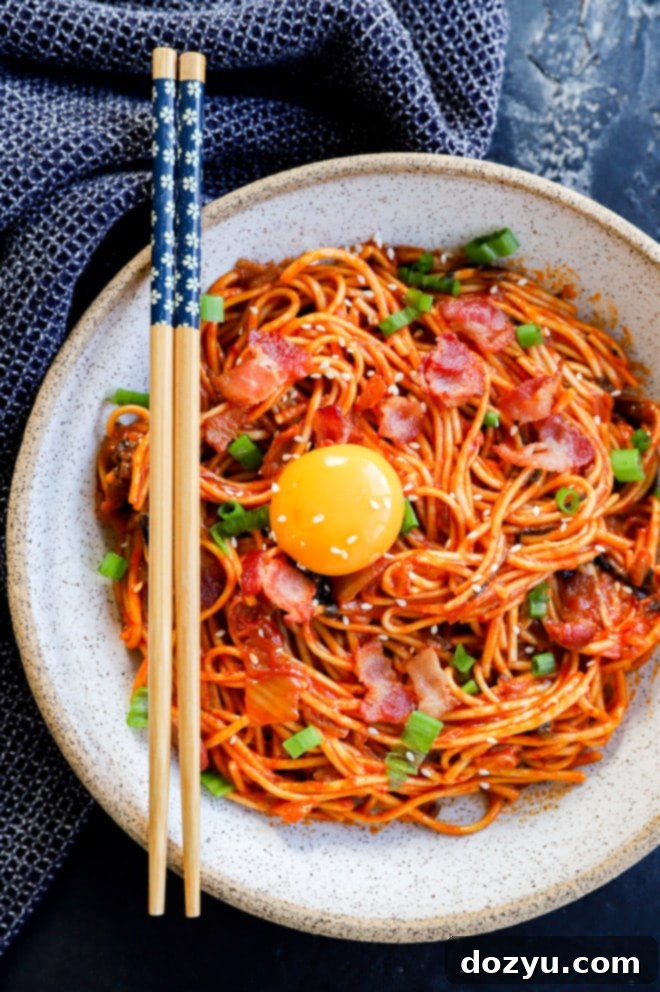
Is Kimchi Udon Always Spicy?
Yes, authentic Kimchi Udon, including this recipe, is designed to be a delightfully spicy dish! The primary sources of heat come from two key Korean ingredients: kimchi and gochujang. Kimchi, being a fermented spicy cabbage, provides a foundational warmth and tang. Gochujang, a fermented chili paste, then amplifies that heat while also adding a unique sweetness and depth.
The beauty of this dish lies in its bold flavors, and the spice is an integral part of that experience. It’s a vibrant, invigorating heat that truly awakens your palate rather than overwhelming it. If you’re a fan of spicy food, you’ll find the heat level in this recipe to be robust and incredibly satisfying. If you’re sensitive to spice, don’t worry – there are ways to slightly reduce the intensity, which we’ll discuss below, but it’s important to know that a certain level of spice is inherent to the dish’s character.
Which Udon Noodles Are Best for This Recipe?
The type of udon noodles you choose can significantly impact the texture of your final dish. Generally, udon noodles are available in three forms: fresh, frozen, and dried.
- Fresh Udon Noodles: These are often found in the refrigerated section of Asian grocery stores. They typically offer the most authentic, soft, and chewy texture, requiring minimal cooking time. If you can get your hands on fresh udon, they are highly recommended.
- Frozen Udon Noodles: A fantastic alternative to fresh, frozen udon noodles are widely available and often maintain an excellent chewy texture. They are usually pre-cooked and just need to be heated through, often by boiling for a minute or two, or sometimes just by soaking in hot water. Many home cooks prefer frozen udon for their convenience and superior texture compared to dried versions.
- Dried Udon Noodles: These are the most common and shelf-stable option, available in most mainstream grocery stores. While convenient, the texture can sometimes be a bit less “chewy” and more “slippery” compared to fresh or frozen varieties. If using dried udon, pay close attention to the package instructions to avoid overcooking, which can lead to a mushy texture. Some brands might require a quick rinse after cooking to remove excess starch.
Ultimately, all three types will work in this recipe, but for the best results, aim for fresh or frozen udon noodles to achieve that ideal thick and springy chewiness that makes this dish so delightful.
Can I Add More Protein or Vegetables to Kimchi Udon?
Absolutely! This creamy kimchi udon recipe is wonderfully versatile and provides an excellent foundation for adding extra protein and vegetables, transforming it into an even heartier and more complete meal. Customizing your udon is not only easy but also encouraged to suit your taste and dietary preferences.
Protein Boosts:
- Chicken: Cooked and shredded chicken breast or thighs can be stirred in with the bacon at the end.
- Steak: Thinly sliced cooked steak (like sirloin or flank steak) works beautifully. You could even quickly sear it in the skillet after the bacon is removed, before making the sauce.
- Pork: Leftover cooked pork, whether shredded or diced, can be a great addition.
- Shrimp: Quickly seared shrimp adds a delicate seafood flavor. Cook the shrimp in a separate pan or in the same skillet after the bacon, then add them back in with the noodles.
- Tofu/Tempeh: For a vegetarian option, press extra-firm tofu, cube it, and pan-fry or air-fry until golden before adding to the dish.
Vegetable Enhancements:
To make this udon noodle dish more of a “kimchi udon stir-fry,” consider incorporating your favorite sautéed vegetables. This is a fantastic way to boost nutrients and add more texture. Some excellent choices include:
- Spinach or Arugula: Stir in fresh greens at the very end of cooking. Their residual heat will wilt them perfectly.
- Zucchini or Bell Peppers: Slice them thinly and sauté them in the bacon fat for a few minutes before adding the kimchi, allowing them to soften slightly.
- Mushrooms: Sliced shiitake or cremini mushrooms add an earthy umami flavor. Sauté them until tender.
- Broccoli or Asparagus: Blanch or steam these vegetables briefly before adding them to the skillet with the noodles to ensure they are cooked through but still crisp.
When adding vegetables, remember to cook them to your desired tenderness. For proteins, ensure they are cooked through before combining them with the sauce and noodles. The possibilities are endless, so feel free to get creative!
How to Reduce the Spiciness of Kimchi Udon
Given that kimchi is inherently spicy and gochujang is a chili paste, toning down the heat significantly while maintaining the authentic flavor profile of this Kimchi Udon can be a bit challenging. However, there are a few strategies you can employ to make the dish milder for those with a lower spice tolerance:
- Reduce Gochujang: The most direct way to lessen the heat is to reduce the amount of gochujang paste you add. Instead of 2 tablespoons, start with 1 tablespoon or even half a tablespoon, and taste the sauce before adding more. Gochujang contributes sweetness and depth beyond just spice, so removing it entirely would alter the flavor considerably.
- Omit Kimchi Juice: The kimchi juice is potent and packed with flavor and heat. You can omit it entirely and replace it with an equal amount of chicken or vegetable broth. This will dilute the overall spiciness of the sauce. Be aware that this might slightly diminish the tangy, fermented kimchi flavor, but it’s an effective way to cut down on heat.
- Increase Dairy (for creaminess, not necessarily less spicy): While not directly reducing the inherent spice, adding a bit more butter or a splash of heavy cream at the end can create a richer, creamier mouthfeel that can sometimes *perceive* the spice as less sharp. This is more about softening the edges of the heat rather than eliminating it.
- Choose Milder Kimchi: If possible, select a brand of kimchi that is known for being milder, or use a younger kimchi which hasn’t had as much time to ferment and develop intense flavors.
- Serve with Cooling Elements: Even if the dish is still spicy, you can balance it at the table. Offer a side of plain rice, a dollop of sour cream or Greek yogurt (though not traditionally Korean, it works wonders for cooling), or even a refreshing cucumber salad to counteract the heat.
Remember, this dish is celebrated for its bold, spicy character. While these tips can help temper the heat, it will still retain some level of spiciness. Experiment to find the perfect balance for your palate!
Need some inspiration for dinners this week? Check out my main dish recipe page!
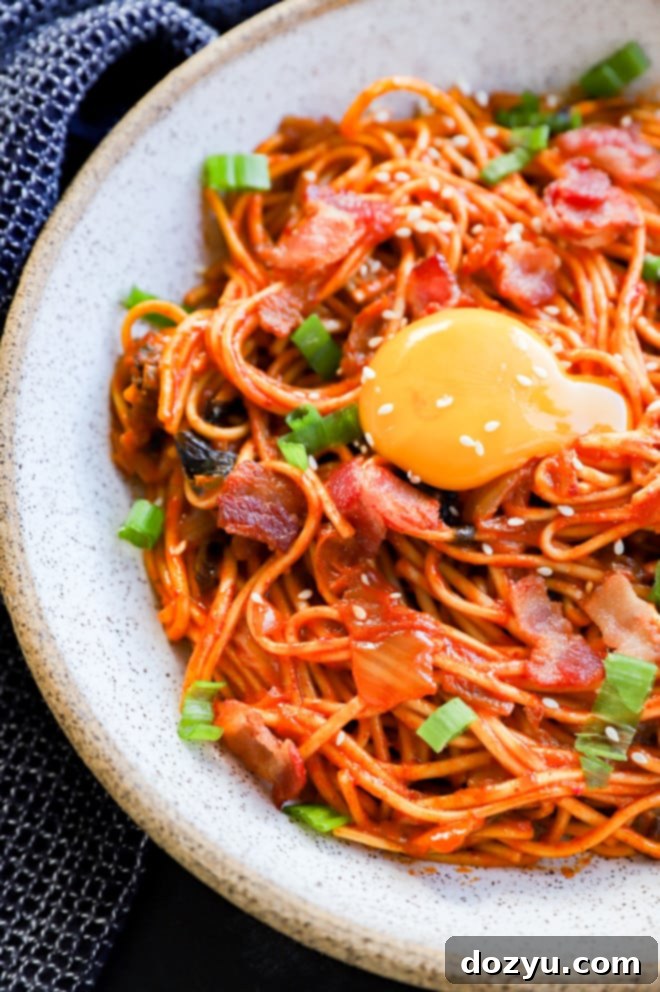
What to Serve with Creamy Kimchi Udon
This Creamy Kimchi Udon is a hearty and flavorful one-skillet meal that truly stands on its own. It’s packed with carbohydrates from the noodles, protein from the bacon (and any optional additions), and a burst of flavor from the kimchi and sauce. However, a few thoughtful additions and garnishes can elevate the experience even further:
Essential Garnishes & Toppings:
- Egg Yolk (or Fried Egg): My absolute favorite way to serve kimchi udon is with a fresh, room-temperature egg yolk nestled on top. When stirred into the hot noodles, it creates an incredibly luscious, extra-creamy sauce that’s simply irresistible. Alternatively, a perfectly cooked sunny-side-up egg or fried egg with a gloriously runny yolk achieves a similar creamy effect and adds another layer of richness.
- Crispy Bacon: Don’t forget to reserve some of that wonderfully crunchy bacon for garnish! The textural contrast it provides against the soft noodles is delightful.
- Fresh Scallions: A generous sprinkle of freshly chopped green onions adds a bright, fresh “zing” and a pop of color that cuts through the richness of the dish.
- Toasted Sesame Seeds: A final flourish of toasted white or black sesame seeds adds a subtle nutty flavor and an appealing visual touch.
- Extra Kimchi: For those who truly love an intense flavor and heat, offering a side of extra chopped kimchi is always a welcome addition.
Light Sides & Complementary Dishes:
Since the udon is quite filling, you don’t need extensive side dishes. However, if you want to round out the meal or add more freshness, consider these simple options:
- Fresh Greens: While you can stir spinach or arugula directly into the hot noodles at the end, a simple side salad with a light vinaigrette could also provide a refreshing counterpoint.
- Pickled Vegetables: Beyond kimchi, other light, tangy pickled vegetables (like quick-pickled cucumbers or daikon radish) can offer a cool, crisp contrast to the spicy noodles.
- Steamed Rice: Although the udon noodles are the main carbohydrate, a small bowl of plain steamed white rice can be a comforting addition, especially if you want to soak up every last drop of the delicious sauce.
Ultimately, the beauty of this Kimchi Udon is its self-sufficiency. But a few simple additions can turn an already fantastic meal into an unforgettable culinary experience.
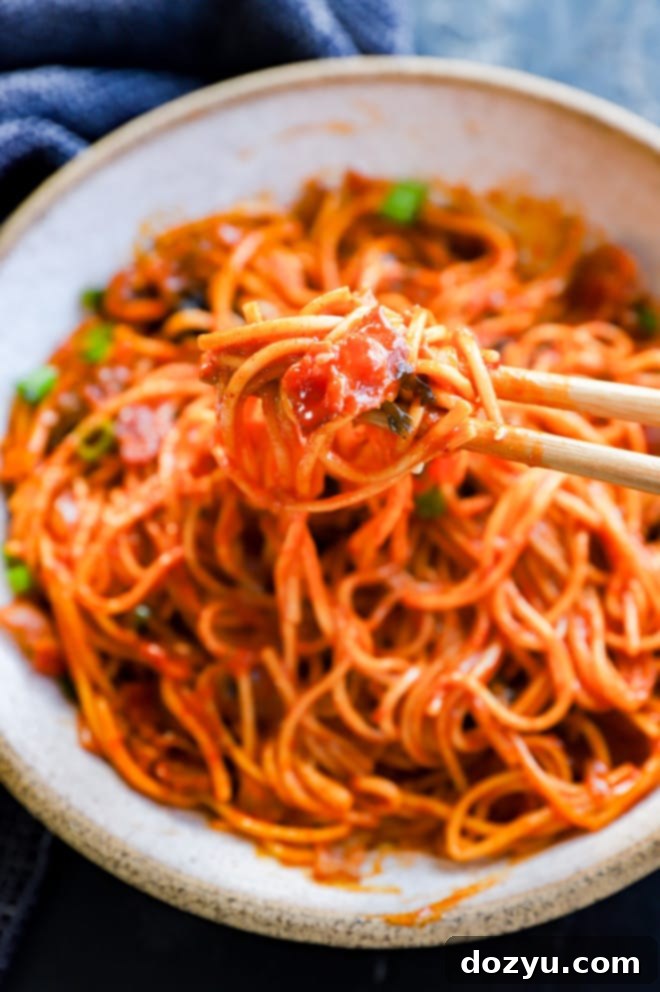
More Quick and Easy Dinner Recipes
If you love the ease and flavor of this Kimchi Udon, you’ll be thrilled to discover more quick and easy dinner recipes that don’t compromise on taste or quality. Here are some other fantastic options to keep your weeknight meals exciting and delicious:
- For a taste of Italy with a fresh twist, try this delightful Lemon Ricotta Pasta with fresh arugula. It’s bright, zesty, creamy, and incredibly satisfying – ready to serve in just 20 minutes!
- Craving something vibrant and healthy? This sweet and savory Mango Chicken Salad offers a tropical flair that’s perfect for warm evenings. Serve it traditionally, or lighten it up as crisp lettuce wraps for a refreshing meal.
- Seafood lovers, rejoice! Whip out your air fryer for this elegant yet simple Air Fryer Scallops recipe. Served with a fragrant chive lemon butter, these tender scallops are incredibly tasty on their own or paired with a light pasta dish.
- If you can’t get enough of Korean-inspired noodles, these Gochujang Noodles with Chicken and Greens are another quick favorite. They offer a similar spicy, savory profile with added chicken and healthy greens.
No matter your craving, these recipes prove that you don’t need to spend hours in the kitchen to enjoy a flavorful and satisfying dinner. Happy cooking!
Finally, if you make this creamy kimchi udon recipe, please be sure to give this recipe a star rating on the recipe card below and/or leave a comment! Your feedback is incredibly valuable, and I truly love hearing about your culinary creations. I make sure to take the time to respond to every single comment and answer any questions you might have.
Oh, and be sure to tag me on Instagram (@cakenknife) if you share your photos of the recipe! It brings me so much joy to see these recipes come to life in your homes – it’s genuinely my favorite thing to look through those beautiful photos. Your engagement means the world to me!
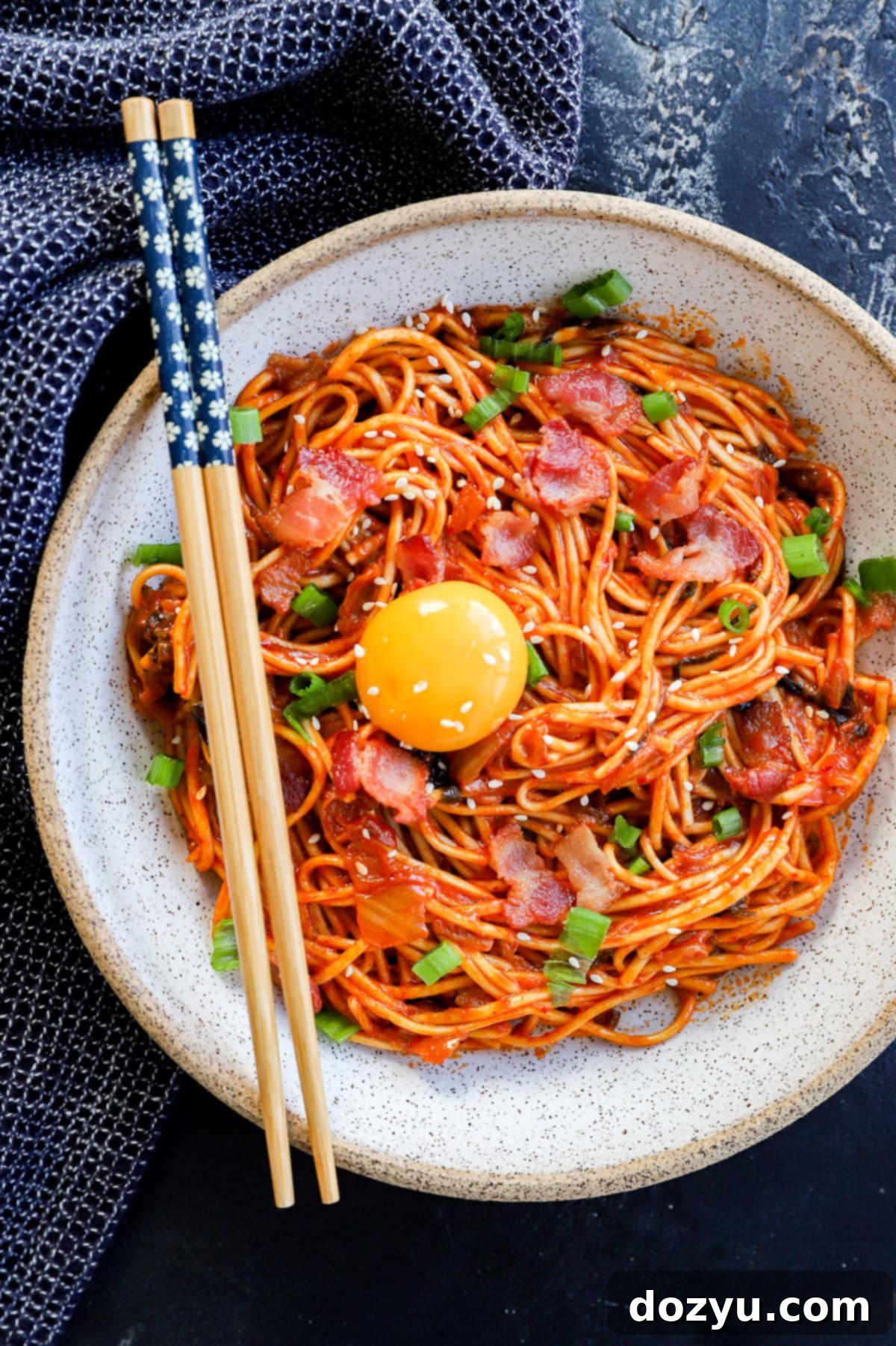
Kimchi Udon Recipe Card
Ingredients
- 4 slices bacon roughly chopped, preferably thick-cut
- 1 lb fresh or frozen udon noodles cooked according to package directions
- 1 cup chopped kimchi choose your favorite brand
- 1/3 cup kimchi juice from the kimchi jar
- 2 Tbsp gochujang paste adjust to your spice preference
- 1/2 cup chicken or vegetable broth low sodium preferred
- 2 Tbsp soy sauce low sodium preferred
- 3 Tbsp unsalted butter or salted, adjust seasoning accordingly
- 4 room temperature egg yolks optional, for extra creaminess
- freshly chopped green onion for garnish
- toasted sesame seeds for garnish (optional)
Instructions
-
In a large skillet over medium-high heat, cook the chopped bacon until it’s crispy and golden, about 3-4 minutes. Carefully remove the cooked bacon to a paper towel-lined plate, reserving it for later. Leave approximately 1 tablespoon of bacon fat in the skillet and discard any excess.
-
Return the skillet to medium-high heat. Add the chopped kimchi and gochujang paste to the reserved bacon fat. Cook, stirring frequently, until the kimchi has softened and begun to lightly caramelize, which should take about 4 minutes. This step is key for deepening the flavor.
-
Stir in the broth, kimchi juice, and soy sauce. Bring the mixture to a gentle simmer and cook for 3-5 minutes, stirring occasionally, until the sauce has thickened and slightly reduced.
-
While the sauce is cooking, prepare the udon noodles according to the package directions. Drain them well once cooked.
-
Add the drained udon noodles and unsalted butter to the skillet with the sauce. Toss vigorously to ensure the noodles are thoroughly coated. Cook for about 2 minutes, allowing the noodles to warm through and absorb the flavors. Stir in most of the crispy bacon, reserving a small amount for garnish. Taste and season with salt and pepper as desired.
-
Divide the creamy kimchi udon among serving bowls. Top each bowl with an optional egg yolk, the reserved crispy bacon, freshly chopped green onions, and a sprinkle of toasted sesame seeds. Serve immediately and enjoy!
